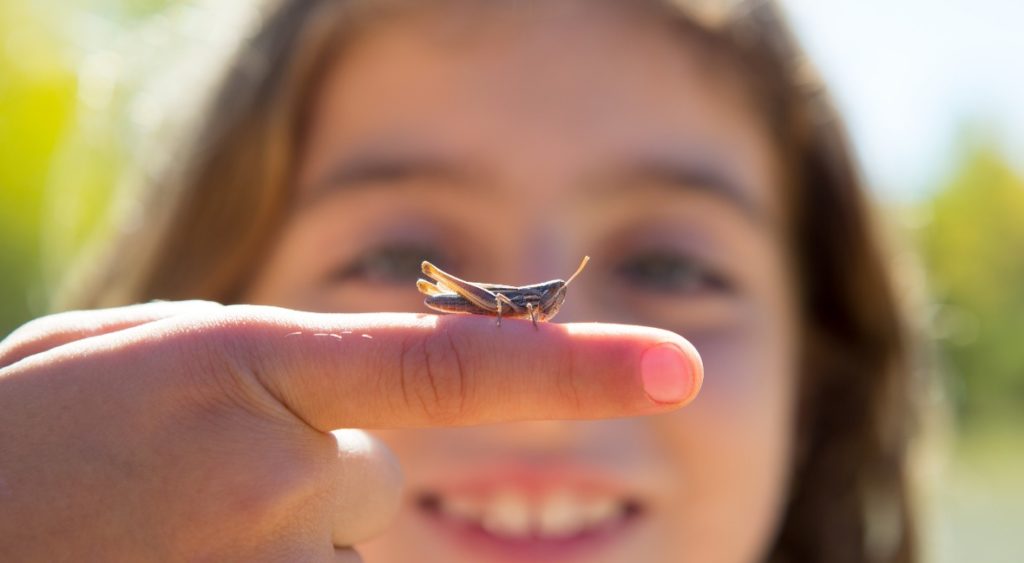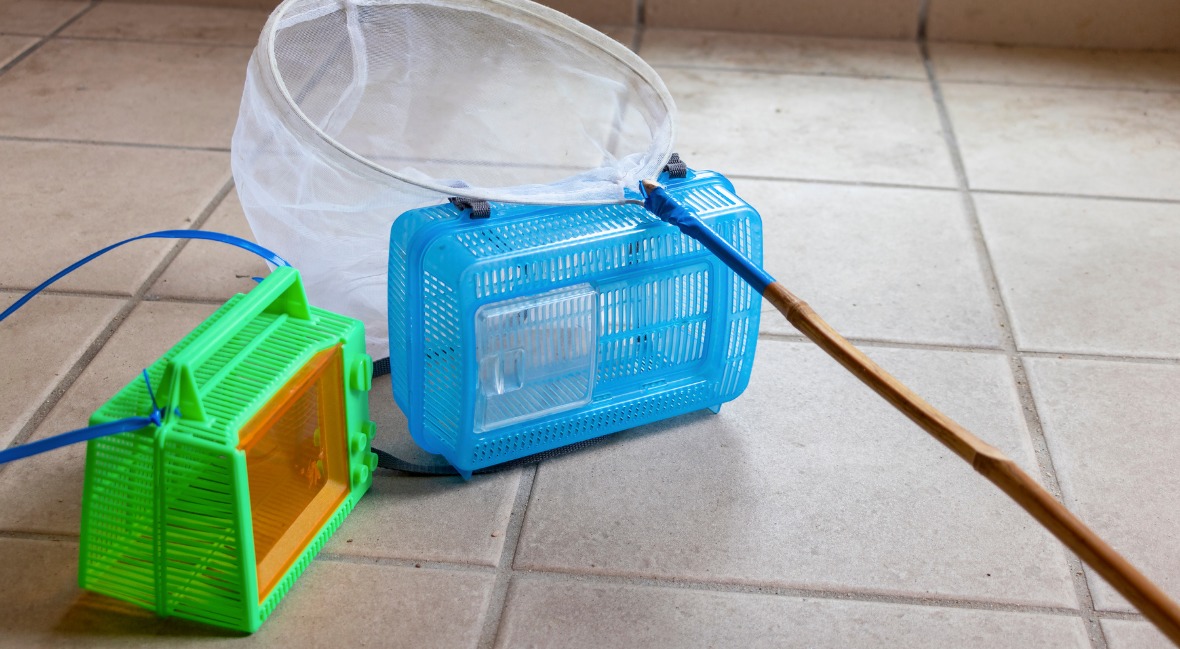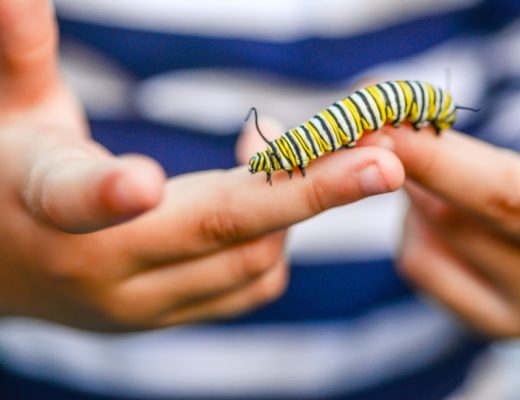Do you have a kid that loves bugs and insects? We remember filling wooden bug boxes with roly-polies collected from around our yards as a kid. We spent hours turning over rocks and digging around to see what we could find and this is still a great free outdoor activity for kids! Providing a kids bug catcher can be a fun way for kids to collect and learn about the things crawling around your backyard.
We’re here to share our tips and advice for buying all the things you need to get your kids ready to do some bug catching – bug boxes, bug nets, and magnifying glasses for kids.
- Don’t have an outdoor space where your kids can catch bugs? Buy an insect kit for kids and try raising ants, worms, ladybugs, butterflies, or ever aqua dragons! They all can make interesting, low-maintenance pets.
In this post:
- Tips for Buying a Kids Bug Catcher
- Kids Bug Catchers
- DIY Bug Boxes
- Bug Catching Nets
- Magnifying Glasses for Kids
- Books About Bugs
- Tips for Catching Bugs
We get commissions for purchases made through links in this post. As an Amazon Associate, we earn from qualifying purchases.
Tips for Buying a Kids Bug Catcher
Avoid lots of pieces. When buying a kids bug catcher, avoid ones that come with lots of small plastic accessories that are more junky toys than tools. These tend to get lost and broken quickly. Instead, we want to provide our kids with real tools and things that will last. A bug box, net, and magnifying glass work well together to help kids catch and observe bugs.
Buy items separately to create your own perfect kit. We found that most of the available bug-catching kits are pretty low quality. If you’re looking for higher-quality tools, it’s going to be best to buy things like bug boxes, magnifying glasses, and nets separately.
Kids Bug Catchers
Backyard Exploration Critter Case

This sturdy kids bug catcher has a carrying handle and is meant to be taken on the go. It features mesh sides and a large door that is simple to open and close. The size of the door makes it easy to get things in and out of the critter case.
There is enough room for multiple bugs as well as sticks, twigs, and leaves.
The mesh sides keep bugs from escaping and allow for excellent viewing, but the mesh can tear.
Check prices for Backyard Exploration Critter Case
Nature Bound Bug Catcher Critter Barn
This bug box has clear plastic sides that are great for viewing bugs and insects. It is water-tight and works for housing aquatic and semi-aquatic critters. It has a carrying handle and a secure lid with holes. The critter shack is sturdy and holds up well to being carried around on adventures.
The holes on the top of the container are large enough to allow ants and other small insects to escape, so beware. The bug box is opened by removing the entire lid. This makes it easy to get things in and out of the box, but it takes a bit of coordination to quickly get the top back on when trying to catch bugs.
Check prices for Nature Bound Bug Catcher Critter Barn
Magnifying Insect Boxes

This set comes with 2 small containers that make it easy to catch and observe bugs. The containers are small enough to be taken on the go, and once the lids are removed, the containers can be placed over bugs to catch them.
Each container has a lid with 2 built-in magnifying glasses. Holes in the cover allow air to enter. The small and clear plastic sizes enable kids to see bugs up close but don’t provide the best space for housing bugs. Kids should release all bugs after observation.
Check prices for Maginfiying Insect Boxes
DIY Bug Boxes
You can take any leftover jar, punch some holes in the lid, and just like that, you have a place to house bugs.

Or you can even make your own bug box if you’re feeling in the mood to use some tools! We recommend making a wide house with a large door. This way, kids can easily get things in and out of the bug box because, yes, they will cram it full of stuff.
Bug Catching Nets
We recommend avoiding kid nets with plastic handles as these are quickly broken. It is important to find a net with a robust handle and rim and a deep net. Nets like this will hold up to lots of swinging, smacking, and bug catching.
EDUCATIONAL SCIENCE WE ENABLE DISCOVERY Butterfly Net

This excellent mesh bug-catching net encourages kids to run around outside. Kids can use it to chase butterflies and other flying insects or sweep it through the grass to catch bugs. The wooden handle and metal rim are sturdy and stand up well to active play.
The net is 12 inches in diameter and 33 inches deep. This makes it easy for kids to trap bugs in the base of the net. But it is relatively long and can be big for younger kids. It’s recommended for kids over the age of 8 but works for kids as young as 5 or 6 years old. If you’re looking for a smaller net, check out the option below.
The net can be paired with a bug box, or kids can release what they catch.
Check prices for EDUCATIONAL SCIENCE WE ENABLE DISCOVERY Butterfly Net
Rngeo Telescopic Butterfly Net

While not quite as robust as the above net, this net is smaller and more manageable for kids under 4. The net is 19.5 inches deep, 11 inches in diameter, and the extendable handle is 15 to 70 inches long. It can be fun for kids to try out different handle lengths, and this can be a nice feature as they grow taller.
The net is inexpensive and holds up well to lots us use. The mesh allows kids to see what they have caught but can snag, rip, or tear.
Check prices for Rngeo Telescopic Butterfly Net
EGO Bait Net

This aquatic net is the perfect option for those looking to collect bugs and things in the water. It pairs well with the water-tight Backyard Safari Critter shack listed above. The wooden handle, metal rim, and mesh are robust.
The handle is 24 inches long, and the net is 8 inches deep.
Kids can use the net to trap other bugs in addition to those found in the water, though the shallow net depth makes it difficult to keep the bugs from jumping out before kids can transfer them to a bug box.
Check prices for EGO Bait Net
Magnifying Glasses for Kids
A magnifying glass can enhance learning and wonder by giving kids a detailed view of bugs and their bodies. Check out our post on the best magnifying glasses for kids.

Books About Bugs
Books are an excellent way for kids to learn more about bugs. Here are fun books about bugs for kids to read and explore. We love books that have real photos instead of drawing so that kids can get an idea of how the various bugs look.
Here are our go-to bug books. You can also head to your local library and allow your kid to pick out additional books about backyard critters.
National Geographic Little Kids First Big Book of Bugs
In this 128 page book, kids will find photos and information about the bugs that they discover every day around their yard, as well as more exotic bugs from around the world. In addition to learning the names of bugs, kids can learn lots of vocabulary words related to bugs.
The book is an excellent read for 4 to 8-year-olds. Even younger kids can enjoy the pictures, but the text may be too advanced for them.
Bugs A to Z
This short paperback book is an excellent introduction to bugs and is geared for kids ages 5 to 7. Younger kids can enjoy looking at the pictures, learning the names of bugs, and begin listening to some of the text.
Each letter of the alphabet features several bugs and includes simple facts and large color pictures. The text is fairly basic and can leave older kids wanting more.
Super Bug Encyclopedia
This book is the perfect resource for older kids with an interest in bugs. It has 208 pages full of detailed text, large color photos and diagrams, and a helpful index at the back of the book. The full-page close-up images show lots of interesting details.
It is geared towards kids who are 8 to 12 years old.
Tips for Catching Bugs
Space to explore. This can be your backyard, the local park, or a hiking trail.
Clothes that can get dirty. Appropriate clothing is key. Kids need clothes that can get dirty, ripped, and stained. Kids should have several sets of comfortable clothing for mucking around outside. Or kids can use some overalls to protect clothing that you don’t want to get stained. We find that kids Carhartt overalls work great for this.
Lots of free time. Kids are driven by their curiosity to explore the world around them. This is how they learn. They need to be given lots of uninterrupted time to observe, touch, move, and try things. Through their own experiences, kids will know where to find bugs and develop methods for catching them.
Look under rocks, in the grass, dig in the dirt. Insects and spiders can be found all over your backyard and even in your house. Kids can wander around and see what they find when they take the time to look.
Use a net. A bug net is a great way to catch insects and lizards. Kids can wave the net through the air to catch flying insects, sweep the net through vegetation and tall grass, or drop the net down on a specific critter as described below.
How to Trap a Bug in a Net:
- Quickly drop the rim of the net to the ground over the bug.
- Slowly drag the rim of the net along the ground to scoot the bug into the net.
- Lift the net and close your fingers around the mesh to trap the bug inside.
- Stand the bug box on end so the door faces the sky and open the door.
- Place the net completely over the bug box, shake the bug in, and close the door.
Be gentle. Insects are living creatures and must be handled gently and returned to where they were found after observations have been made.
Take notes. Kids can use a notebook for drawing and writing down what they observe. They can note things like color, size, number of legs, and where they discovered the insect. We love using a weatherproof notebook that holds up even when it gets wet.
Kids can then compare their notes with a bug book or field guide to identify their finds.
Leave snakes, birds, and nests alone. We want to avoid disturbing nests and eggs or injuring birds with a net. Instead, kids can observe birds without trying to catch them. Snakes can be poisonous and should also be avoided.

Final Thoughts on Kids Bug Catchers
We want to encourage kids to learn from the world around them. A kids bug catcher and some time will give kids real-life, hands-on experiences and deeper learning than anything we could be doing in a classroom.
Support kids in their curiosity and note all the learning they’re doing daily when they explore outside. It’s easy to see how kids are developing across the 4 developmental domains (cognitive, physical, social-emotional, and language-literacy development)!











No Comments